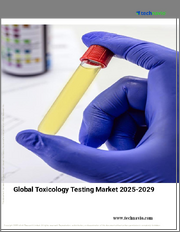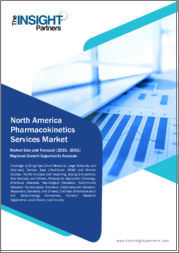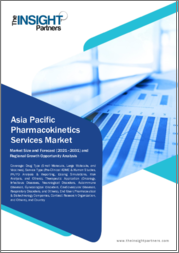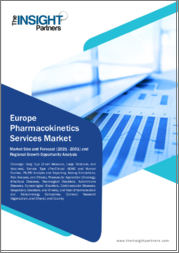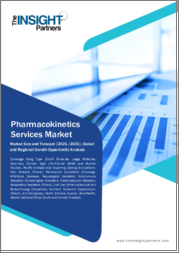
|
시장보고서
상품코드
1403336
세계의 독성 시험 시장 예측(-2030년) : 제품별, 시험 유형별, 방법별, 기술별, 최종 사용자별, 지역별 분석Toxicology Testing Market Forecasts to 2030 - Global Analysis By Product, Test Type, Method, Technology, End User and By Geography |
||||||
세계 독성 시험 시장 규모는 예측 기간 동안 15.9%의 연평균 복합 성장률(CAGR)로 성장할 것으로 예상되고 있습니다.
독성 시험은 인간의 건강과 환경에 대한 잠재적 위험을 평가하기 위해 물질이 생물체에 미치는 영향을 평가하는 것을 포함합니다. 화학물질, 의약품, 소비자 제품, 환경오염물질과 관련된 안전성, 독성 및 위험을 판단합니다. 그 중요성은 위험 식별 및 완화, 규제 준수 지원, 제품 개발 지침으로 공중 보건을 보호하는 것입니다.
NCBI에 따르면, 탐색 단계에서 합성된 10,000개 화합물에 대해 전임상 단계에 도달하는 것은 단지 250개의 화합물이며, 결국 FDA에 승인되는 의약품은 하나입니다.
R&D 활동 증가
제약, 생명공학, 화학제조 등의 업계에서는 신규 화합물, 제제, 제품의 탐구가 끊임없이 이루어지고 있습니다. 독성 시험은 이러한 혁신 기술의 안전성, 효능 및 잠재적 위험을 시장 도입 전에 평가함으로써 이러한 부문에서 매우 중요한 역할을 합니다. 또한 견고한 독성 평가는 규제 기준을 준수하고 사람의 건강과 환경에 미치는 악영향을 줄이는 데 도움이 됩니다. 소비자의 요구 변화와 기술의 비약적 진보에 대응하기 위한 연구개발 노력이 높아짐에 따라 철저한 독성시험의 필요성이 높아지고 있으며, 신규의약품, 화학물질, 제품의 창출과 승인에 필수적 한 단계입니다.
데이터 분석의 복잡성
많은 실험과 최첨단 기술에서 얻은 복잡하고 다양한 데이터는 분석에 어려움을 유발하고 유용한 통찰력으로 전환하기가 어렵습니다. 이 복잡성을 정확하게 평가하려면 특정 지식, 고급 장비 및 표준화된 프레임워크가 필요합니다. 이러한 복잡한 통계 데이터를 해석할 때의 오류나 불확실성은 위험 평가, 규제 당국 신청, 제품 개발의 의사결정을 훼손하고 시장 승인 및 개발을 방해할 수 있습니다.
대체 시험법에 대한 수요 증가
시험관내 분석, 오가노이드, 마이크로플루이딕스 시스템, 컴퓨팅 모델과 같은 첨단 기술은 독성 평가에 유망한 대안을 제공하며, 보다 정확하고 비용 효율적이며 윤리적인 시험 수단을 제공합니다. 이러한 대체법을 검증하고 상업화하기 위한 연구개발에 투자하는 기업은 이러한 수요가 증가함에 따라 자본투하하는 입장에 있습니다. 게다가, 이러한 대안이 널리 채택됨으로써, 시험 과정이 간소화되고, 더 빠른 결과를 얻을 수 있게 되고, 보다 인도적이고 예측 가능한 독성 평가를 요구하는 세계 동향과도 일치합니다. 이와 같이 시장 확대의 원동력이 되고 있습니다.
규제 변화
안전성 평가를 관리하는 규제의 진화와 엄격화는 시험 방법, 검증 요건 및 제품 승인 타임라인에 영향을 미치기 때문에 지속적인 적응과 준수가 필요합니다. 규제 기준의 갑작스런 변화와 새로운 가이드라인의 도입은 불확실성, 비용 증가, 승인 프로세스 지연으로 이어질 수 있습니다. 신규 기준에 신속하게 대응할 수 없는 경우, 컴플라이언스 위반의 벌칙, 경쟁력의 저하, 시장 진입의 저해로 이어질 가능성이 있어, 독성 시험 시장에서 효율성을 유지해, 진화하는 요건에 대응하는 것이 기업에 있어서 과제가 됩니다.
COVID-19의 영향
COVID-19의 발생은 처음에는 운영 중단과 연구에 미치는 영향으로 자원을 유행 관련 연구로 향하게 되었습니다. 테스트 및 규제 프로세스 지연이 계속되었고 제품 승인이 지연되었습니다. 그러나 이 위기는 백신 개발과 의약품 안전성 평가에서 독성시험의 중요성을 부각시키고 그 중요성을 높였습니다. 업계는 원격 근무과 가상 테스트를 통해 대응하여 혁신과 디지털화를 촉진했습니다. 안전성 평가에 대한 인식이 높아진 결과, 견고한 조사 방법이 재차 중시되고, 팬대믹 이후의 회복의 길이 열렸습니다.
예측 기간 동안 유전자 독성 시험 부문이 최대가 될 전망
유전자 독성 시험 부문이 가장 큰 점유율을 차지하는 것으로 추정됩니다. 유전자 독성 시험은 물질의 돌연변이, 염색체 이상, DNA 손상을 유발하는 능력을 평가하는 분석을 채용하고 있어, 잠재적인 발암 물질이나 유해 화합물을 특정하는데 있어서 매우 중요합니다. 이러한 시험에는 에임스 시험, 소핵 시험, 코멧 시험 등의 체외·생체내의 방법이 포함되어 유전 독성을 종합적으로 분석합니다. 또한, 유전자 독성을 이해하면 의약품, 화학물질, 농약, 소비자 제품의 안전성을 판단하는 데 도움이 되며, 규제 평가에 크게 기여하며 유해한 유전자 변화로부터 사람의 건강과 환경을 보장합니다. 보호합니다.
예측 기간 동안 연평균 복합 성장률(CAGR)이 가장 높을 것으로 예상되는 것은 생체내 시험 부문입니다.
예측 기간 동안 생체내 시험 부문은 유리한 성장을 달성할 것으로 예측됩니다. 생체내 시험이란 식물이나 동물 등 살아있는 생물 전체에서 실시되는 실험의 일종입니다. 독성 수준, 유해 반응, 잠재적인 건강 피해를 결정하는 데 도움이 되며 규제 평가 및 안전성 평가에 중요한 데이터를 제공합니다. 또한, 윤리적 고려에도 불구하고, 이러한 시험은 물질의 생물학적 영향을 종합적으로 이해하고 잠재적으로 유해한 화합물로부터 사람의 건강과 환경을 안전하게 보호하는 데 필수적입니다.
최대 점유율을 차지하는 지역
아시아태평양은 산업화의 진전, 규제 지침의 엄격화, 환경 안전성에 대한 의식 증가로 예측 기간 동안 최대 시장 점유율을 차지했습니다. 기술의 진보, 제약·바이오테크놀러지 부문의 확대, 화장품이나 식품 산업에 있어서의 독성 평가에 수요가, 시장 확대의 원동력이 되고 있습니다. 게다가 중국, 인도, 일본, 한국 등의 국가들은 경제 확대와 연구 이니셔티브의 확대로 매우 중요한 공헌을 하고 있습니다. 이 시장의 성장을 뒷받침하는 것은 제품의 안전성 평가가 중요하고 신뢰성이 높은 독성 시험 방법이 필요하다는 것입니다.
CAGR이 가장 높은 지역:
북미는 엄격한 규제 체제, 제품 안전에 대한 관심이 높아지고 기술이 발전함에 따라 예측 기간 동안 수익성 높은 성장을 이룰 것으로 예상됩니다. 이 지역은 제약·바이오테크놀러지 산업이 확립하고 있어 연구개발 활동도 활발해지고 있기 때문에 시장의 확대가 전망되고 있습니다. 또한, 화학물질에 대한 노출에 대한 우려 증가와 의료, 화장품, 환경 모니터링 등 다양한 부문의 효율적인 독성 평가의 필요성이 시장 성장을 가속하고 있습니다. 미국과 캐나다와 같은 주요 공헌국들은 시험 기법의 지속적인 발전을 목격하고 있으며 기술 혁신과 시장 침투를 촉진하고 있습니다.
무료 주문을 받아서 만드는 서비스:
이 보고서를 구독하는 고객은 다음 무료 맞춤설정 옵션 중 하나를 사용할 수 있습니다.
- 기업 프로파일
- 추가 시장 기업의 종합적 프로파일링(3개사까지)
- 주요 기업의 SWOT 분석(3개사까지)
- 지역 세분화
- 고객의 관심에 응한 주요국 시장 추계, 예측, CAGR(주: 타당성 확인에 따름)
- 경쟁 벤치마킹
- 제품 포트폴리오, 지리적 존재, 전략적 제휴에 기반한 주요 기업 벤치마킹
목차
제1장 주요 요약
제2장 서문
- 개요
- 이해관계자
- 조사 범위
- 조사 방법
- 데이터 마이닝
- 데이터 분석
- 데이터 검증
- 조사 접근
- 조사 소스
- 1차 조사 소스
- 2차 조사 소스
- 전제조건
제3장 시장 동향 분석
- 성장 촉진요인
- 억제요인
- 기회
- 위협
- 제품분석
- 기술 분석
- 최종 사용자 분석
- 신흥 시장
- COVID-19의 영향
제4장 Porter's Five Forces 분석
- 공급기업의 협상력
- 구매자의 협상력
- 대체품의 위협
- 신규 참가업체의 위협
- 경쟁 기업간 경쟁 관계
제5장 세계의 독성 시험 시장 : 제품별
- 기기
- 시약 및 키트
- 기타 제품
제6장 세계의 독성 시험 시장 : 시험 유형별
- 유전독성시험
- 발암성 시험
- 발달 및 생식독성시험
- 기타 시험 유형
제7장 세계의 독성 시험 시장 : 방법별
- 생화학 시험
- 혈액학 시험
- 병리 시험
제8장 세계의 독성 시험 시장 : 기술별
- 생체내 시험
- 체외시험
제9장 세계의 독성 시험 시장 : 최종 사용자별
- 음식업계
- 제약회사 및 바이오테크놀러지회사
- 화장품 및 퍼스널케어 산업
- 학술연구기관
- 기타 최종 사용자
제10장 세계의 독성 시험 시장 : 지역별
- 북미
- 미국
- 캐나다
- 멕시코
- 유럽
- 독일
- 영국
- 이탈리아
- 프랑스
- 스페인
- 기타 유럽
- 아시아태평양
- 일본
- 중국
- 인도
- 호주
- 뉴질랜드
- 한국
- 기타 아시아태평양
- 남미
- 아르헨티나
- 브라질
- 칠레
- 기타 남미
- 중동 및 아프리카
- 사우디아라비아
- 아랍에미리트(UAE)
- 카타르
- 남아프리카
- 기타 중동 및 아프리카
제11장 주요 발전
- 계약, 파트너십, 협업, 합작투자(JV)
- 인수와 합병
- 신제품 발매
- 사업 확대
- 기타 주요 전략
제12장 기업 프로파일
- Abbott Laboratories
- Eurofins Scientific
- Laboratory Corporation Of America Holdings
- Thermo Fisher Scientific, Inc.
- Danaher Corporation
- Agilent Technolgies, Inc.
- Catalent, Inc.
- Bio-Rad Laboratories, Inc.
- Bioivt
- Gentronix
According to Stratistics MRC, the Global Toxicology Testing Market is growing at a CAGR of 15.9% during the forecast period. Toxicology testing involves evaluating the effects of substances on living organisms to assess potential hazards to human health and the environment. It determines the safety, toxicity, and risks associated with chemicals, pharmaceuticals, consumer products, and environmental pollutants. Its importance lies in safeguarding public health by identifying and mitigating risks, aiding regulatory compliance, and guiding product development.
According to NCBI, for every 10,000 compounds synthesized in the discovery phase, only 250 reach the preclinical phase, ultimately resulting in one approved drug by the FDA.
Market Dynamics:
Driver:
Increasing R&D activities
Industries such as pharmaceuticals, biotechnology, and chemical manufacturing are continually exploring novel compounds, formulations, and products. Toxicology testing plays a pivotal role in these sectors by evaluating the safety, efficacy, and potential risks of these innovations before market introduction. Moreover, robust toxicological assessments ensure compliance with regulatory standards and help mitigate adverse effects on human health and the environment. The need for thorough toxicological testing is growing as R&D efforts to address changing consumer demands and technological breakthroughs rise, making it an essential step in the creation and approval of novel medications, chemicals, and products.
Restraint:
Complexity in data interpretation
The complex and varied data produced by many experiments and cutting-edge technologies presents analytical difficulties that make it difficult to analyze and translate into useful insights. Accurate assessment of this complexity necessitates specific knowledge, advanced instruments, and standardized frameworks. Errors or uncertainty when interpreting these complex statistics can impair decision-making in risk assessments, regulatory filings, and product development, thereby impeding market approvals and developments.
Opportunity:
Growing demand for alternative testing methods
Advanced technologies such as in vitro assays, organoids, microfluidics systems, and computational models offer promising alternatives for toxicology assessments, providing more accurate, cost-effective, and ethical testing avenues. Companies investing in research and development to validate and commercialize these alternative methods stand to capitalize on this growing demand. Moreover, the widespread adoption of these alternatives also streamlines testing processes, fosters quicker results, and aligns with the global trend towards more humane and predictive toxicology evaluations. Thus, there is propelling market expansion.
Threat:
Regulatory changes
Evolving and stringent regulations governing safety assessments necessitate continuous adaptation and compliance, impacting testing methodologies, validation requirements, and timelines for product approvals. Sudden shifts in regulatory standards or the introduction of new guidelines may lead to uncertainties, increased costs, and delays in the approval process. Failure to promptly align with new standards could result in non-compliance penalties, reduced competitiveness, and impediments to market access, posing challenges for companies in maintaining efficiency and meeting evolving requirements within the toxicology testing market.
COVID-19 Impact
The COVID-19 outbreak initially affected operations and research due to lockdowns and redirected resources towards pandemic-related studies. Delays in trials and regulatory processes ensued, slowing down product approvals. However, the crisis highlighted the criticality of toxicology testing in vaccine development and drug safety assessments, elevating its importance. The industry adapted with remote work and virtual trials, fostering innovation and digitalization. Increased awareness of safety evaluations resulted in a renewed emphasis on robust testing methodologies, paving the way for a resilient recovery post-pandemic.
The genetic toxicology testing segment is expected to be the largest during the forecast period
The genetic toxicology testing segment is estimated to hold the largest share. Genetic toxicology testing employs assays to evaluate a substance's ability to induce mutations, chromosomal aberrations, or DNA damage, which is crucial in identifying potential carcinogens or harmful compounds. These tests encompass in vitro and in vivo methods, such as the Ames test, micronucleus assay, and comet assay, to comprehensively analyze genotoxicity. Moreover, understanding genetic toxicity aids in determining the safety of pharmaceuticals, chemicals, pesticides, and consumer products, contributing significantly to regulatory evaluations, and ensuring the protection of human health and the environment from harmful genetic alterations.
The in-vivo testing segment is expected to have the highest CAGR during the forecast period
The in-vivo testing segment is anticipated to have lucrative growth during the forecast period. In vivo tests refer to a type of experiment that is carried out within a whole, living organism, such as a plant or animal. It helps to determine toxicity levels, adverse reactions, and potential health hazards, providing crucial data for regulatory assessments and safety evaluations. Moreover, these tests, despite ethical considerations, remain essential for comprehensively understanding the biological effects of substances and ensuring the protection of human health and the environment from potentially harmful compounds.
Region with largest share:
Asia Pacific commanded the largest market share during the extrapolated period owing to increasing industrialization, stringent regulatory guidelines, and rising awareness regarding environmental safety. Advancements in technology and expanding pharmaceutical and biotechnology sectors, coupled with the demand for toxicological evaluations in the cosmetics and food industries, drive market expansion. Moreover, countries like China, India, Japan, and South Korea are pivotal contributors due to their expanding economies and growing research initiatives. This market's growth is fuelled by the emphasis on product safety assessment and the need for reliable toxicology testing methods.
Region with highest CAGR:
North America is expected to witness profitable growth over the projection period, due to stringent regulatory frameworks, heightened focus on product safety, and technological advancements. The region's well-established pharmaceutical and biotechnology industries, along with increased R&D activities, propel market expansion. Moreover, rising concerns about chemical exposure, coupled with the need for efficient toxicological evaluations in various sectors, including healthcare, cosmetics, and environmental monitoring, are driving market growth. Key contributors like the United States and Canada witness continual advancements in testing methodologies, fostering innovation and market penetration.
Key players in the market:
Some of the key players in the Toxicology Testing Market include Abbott Laboratories, Eurofins Scientific, Laboratory Corporation Of America Holdings, Thermo Fisher Scientific, Inc., Danaher Corporation, Agilent Technolgies, Inc., Catalent, Inc., Bio-Rad Laboratories, Inc., Bioivt and Gentronix.
Key Developments:
In November 2023, Thermo Fisher Scientific & Flagship Pioneering Expand Ongoing Strategic Partnership to Jointly Create New Platform Companies with First-in-Class Enabling Technologies for Life Sciences.
In October 2023, Thermo Fisher Scientific, the world leader in serving science, has introduced the Thermo Scientific™ Meridian™ EX System- an electron-beam-based failure analysis solution designed to enable precise fault localization on advanced semiconductor logic technologies.
In September 2023, Thermo Fisher Scientific and National Minority Quality Forum Collaborate to support biopharmaceutical and biotech customers in meeting regulatory expectations to enroll and retain patients in clinical trials who more fully reflect real-world populations experiencing the disease or health condition being studied, including U.S. Food and Drug Administration requirements around diversity action plans.
Products Covered:
- Instruments
- Reagents and Kits
- Other Products
Test Types Covered:
- Genetic Toxicology Testing
- Carcinogenicity Testing
- Developmental and Reproductive Toxicology Testing
- Other Test Types
Methods Covered:
- Biochemical Testing
- Hematology Testing
- Pathology Testing
Technologies Covered:
- In-vivo Testing
- In-vitro Testing
End Users Covered:
- Food and Beverage Industry
- Pharmaceutical and Biotechnology Companies
- Cosmetics and Personal Care Industry
- Academic and Research Institutions
- Other End Users
Regions Covered:
- North America
- US
- Canada
- Mexico
- Europe
- Germany
- UK
- Italy
- France
- Spain
- Rest of Europe
- Asia Pacific
- Japan
- China
- India
- Australia
- New Zealand
- South Korea
- Rest of Asia Pacific
- South America
- Argentina
- Brazil
- Chile
- Rest of South America
- Middle East & Africa
- Saudi Arabia
- UAE
- Qatar
- South Africa
- Rest of Middle East & Africa
What our report offers:
- Market share assessments for the regional and country-level segments
- Strategic recommendations for the new entrants
- Covers Market data for the years 2021, 2022, 2023, 2026, and 2030
- Market Trends (Drivers, Constraints, Opportunities, Threats, Challenges, Investment Opportunities, and recommendations)
- Strategic recommendations in key business segments based on the market estimations
- Competitive landscaping mapping the key common trends
- Company profiling with detailed strategies, financials, and recent developments
- Supply chain trends mapping the latest technological advancements
Free Customization Offerings:
All the customers of this report will be entitled to receive one of the following free customization options:
- Company Profiling
- Comprehensive profiling of additional market players (up to 3)
- SWOT Analysis of key players (up to 3)
- Regional Segmentation
- Market estimations, Forecasts and CAGR of any prominent country as per the client's interest (Note: Depends on feasibility check)
- Competitive Benchmarking
- Benchmarking of key players based on product portfolio, geographical presence, and strategic alliances
Table of Contents
1 Executive Summary
2 Preface
- 2.1 Abstract
- 2.2 Stake Holders
- 2.3 Research Scope
- 2.4 Research Methodology
- 2.4.1 Data Mining
- 2.4.2 Data Analysis
- 2.4.3 Data Validation
- 2.4.4 Research Approach
- 2.5 Research Sources
- 2.5.1 Primary Research Sources
- 2.5.2 Secondary Research Sources
- 2.5.3 Assumptions
3 Market Trend Analysis
- 3.1 Introduction
- 3.2 Drivers
- 3.3 Restraints
- 3.4 Opportunities
- 3.5 Threats
- 3.6 Product Analysis
- 3.7 Technology Analysis
- 3.8 End User Analysis
- 3.9 Emerging Markets
- 3.10 Impact of Covid-19
4 Porters Five Force Analysis
- 4.1 Bargaining power of suppliers
- 4.2 Bargaining power of buyers
- 4.3 Threat of substitutes
- 4.4 Threat of new entrants
- 4.5 Competitive rivalry
5 Global Toxicology Testing Market, By Product
- 5.1 Introduction
- 5.2 Instruments
- 5.3 Reagents and Kits
- 5.4 Other Products
6 Global Toxicology Testing Market, By Test Type
- 6.1 Introduction
- 6.2 Genetic Toxicology Testing
- 6.3 Carcinogenicity Testing
- 6.4 Developmental and Reproductive Toxicology Testing
- 6.5 Other Test Types
7 Global Toxicology Testing Market, By Method
- 7.1 Introduction
- 7.2 Biochemical Testing
- 7.3 Hematology Testing
- 7.4 Pathology Testing
8 Global Toxicology Testing Market, By Technology
- 8.1 Introduction
- 8.2 In-vivo Testing
- 8.3 In-vitro Testing
9 Global Toxicology Testing Market, By End User
- 9.1 Introduction
- 9.2 Food and Beverage Industry
- 9.3 Pharmaceutical and Biotechnology Companies
- 9.4 Cosmetics and Personal Care Industry
- 9.5 Academic and Research Institutions
- 9.6 Other End Users
10 Global Toxicology Testing Market, By Geography
- 10.1 Introduction
- 10.2 North America
- 10.2.1 US
- 10.2.2 Canada
- 10.2.3 Mexico
- 10.3 Europe
- 10.3.1 Germany
- 10.3.2 UK
- 10.3.3 Italy
- 10.3.4 France
- 10.3.5 Spain
- 10.3.6 Rest of Europe
- 10.4 Asia Pacific
- 10.4.1 Japan
- 10.4.2 China
- 10.4.3 India
- 10.4.4 Australia
- 10.4.5 New Zealand
- 10.4.6 South Korea
- 10.4.7 Rest of Asia Pacific
- 10.5 South America
- 10.5.1 Argentina
- 10.5.2 Brazil
- 10.5.3 Chile
- 10.5.4 Rest of South America
- 10.6 Middle East & Africa
- 10.6.1 Saudi Arabia
- 10.6.2 UAE
- 10.6.3 Qatar
- 10.6.4 South Africa
- 10.6.5 Rest of Middle East & Africa
11 Key Developments
- 11.1 Agreements, Partnerships, Collaborations and Joint Ventures
- 11.2 Acquisitions & Mergers
- 11.3 New Product Launch
- 11.4 Expansions
- 11.5 Other Key Strategies
12 Company Profiling
- 12.1 Abbott Laboratories
- 12.2 Eurofins Scientific
- 12.3 Laboratory Corporation Of America Holdings
- 12.4 Thermo Fisher Scientific, Inc.
- 12.5 Danaher Corporation
- 12.6 Agilent Technolgies, Inc.
- 12.7 Catalent, Inc.
- 12.8 Bio-Rad Laboratories, Inc.
- 12.9 Bioivt
- 12.10 Gentronix







